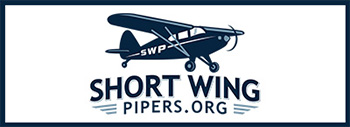Welcome! Becoming a registered user of ShortWingPipers.Org is free and easy! Click the "Register" link found in the upper right hand corner of this screen. It's easy and you can then join the fun posting and learning about Short Wing Pipers!
-

 Float Takeoff Trim
Float Takeoff Trim
I have been experimenting with float takeoffs and wanted to report an observation.
First I should say I'm flying a stretched pacer aka Bushmaster with a 180 hp motor and 2440 floats, standard pacer tailfeathers.
I have found that if I make a standard takeoff (trim neutral, one notch flaps, hold the yolk back until the second rise then ease forward until you gain some speed then let if fly off) when heavy I have to push the nose over after the second rise. I'm working on developing the right touch for that push over the top.
I have experimented with trimming all the way forward. When I do that I don't have to push the nose over, and I also get a significantly shorter takeoff run. I'm not sure why that is, but it really seems to work.
The only downside I have noticed is that after takeoff I spend a lot of time cranking on the trim.
I have a couple of theories on why a forward trimmed takeoff may be shorter.
1) Maybe it noses over with a more proper amount of force after the second rise with forward trim. I try to push it over gently when trimmed neutral, but it can be hard to judge.
2) Maybe the nose up forces of neutral trim plus yolk full back are higher when trimmed neutral, and I'm dragging the float heels too hard. Would a neutral yolk through the second rise would have the same result as forward trimming?
3) Maybe the forward trim is pushing the nose lower when running on the step, getting me deeper into the "sweet spot" than I normally get with neutral trim. It's psychologically hard to push the nose forward when you're running on the step. Harder than just releasing a little back pressure.
Whatever it is, if I'm loaded heavy I get up on the step and off the water sooner if I trim the nose all the way down.
Interested to hear other people's opinions. Also wondering if this works on wheel takeoffs.
Tags for this Thread
 Posting Permissions
Posting Permissions
- You may not post new threads
- You may not post replies
- You may not post attachments
- You may not edit your posts
-
Forum Rules


 Thanks:
Thanks:  Likes:
Likes: 




 Reply With Quote
Reply With Quote